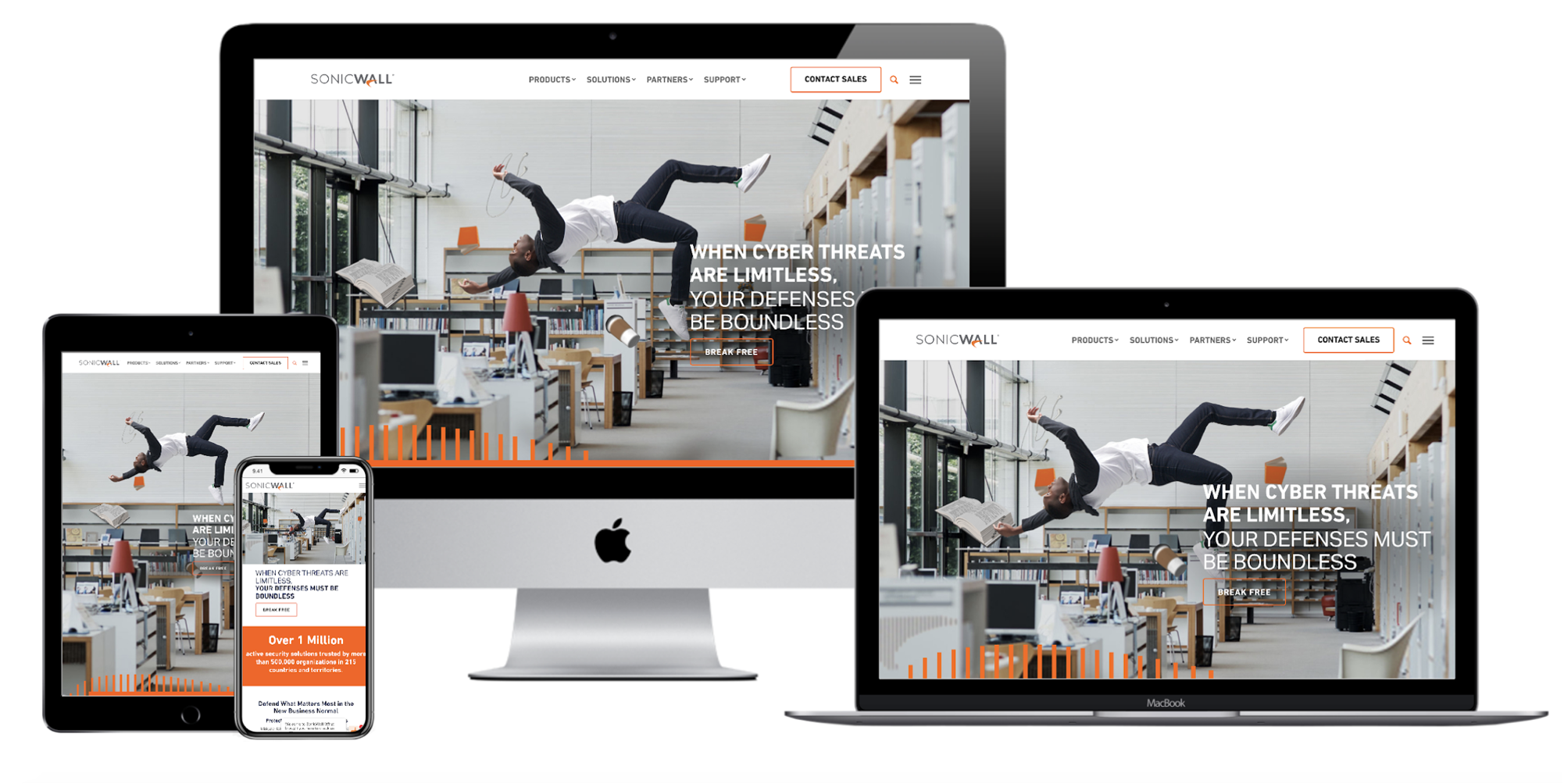In our modern world, nearly all marketing campaigns integrate some level of digital communication to broaden their reach across their target market. But technology is changing so fast that it can be difficult to keep up with the latest and greatest. And let’s face it, trends have an expiration date. So how do marketers know what digital assets will be the most effective for their campaigns and how do they know what will stand the test of time? Let’s take a look at some digital marketing trends with timeless potential:
1. Quality UX
With more and more digital users every year, it is more important now than ever to make your presence known in the digital sphere. Though, checking off the box for “having a website” doesn’t mean that you can sit on it and let it be. It is important to ensure that your website continuously provides a quality user experience for your end-users to keep them coming back and that it appears modern and relevant to new users.
Whether you are looking to update the look and feel of your website every two or three years, or keep your content strategy up-to-date every few months, it is important to connect with a digital marketing agency, like Bluetext, who can work with you to create a well-informed and exciting new website plan. Digital marketers can work with you to keep your thought leadership up to date, create a new digital brand presence, and develop a smart, sustainable navigation strategy to ensure that your users are able to find what they are looking for on your website. User experience is a broad discipline, with many proven principles that should lay the foundation of every unique design. Quality, well-informed UX will help drive leads, make conversions, and ultimately boost revenue for your business.
2. Virtual Events
We know that the coronavirus pandemic led to a hunkered-down workforce, many working from the confines of their makeshift home offices and connecting with coworkers and clients virtually. Large-scale events were unimaginable and virtual events quickly took their place.
Virtual events are exactly what they sound like ― virtual. This means that attendees don’t need to travel to attend a virtual event as they can enjoy them from the comfort of their own homes. No venue means no geographical constraints and the elimination of travel expenses. Attendees can join from all across the country, and all around the globe without costing their companies a dime.
Virtual events also allow companies to shift their budget away from venue fees and reallocate it toward production costs for their event. High-quality production captures and sustains attendee attention. If your event is lacking in production value, your attendees will be more inclined to spend time on their email instead of participating and actively listening to your hosts and guests.
See how SonicWall successfully garnered a 135% increase in attendance over their previous high-mark partner event. The high-quality production of pre-recorded videos, a custom website with a quasi-live experience, and motion graphics all worked together to untie attendees in a shared interest no matter their physical location.
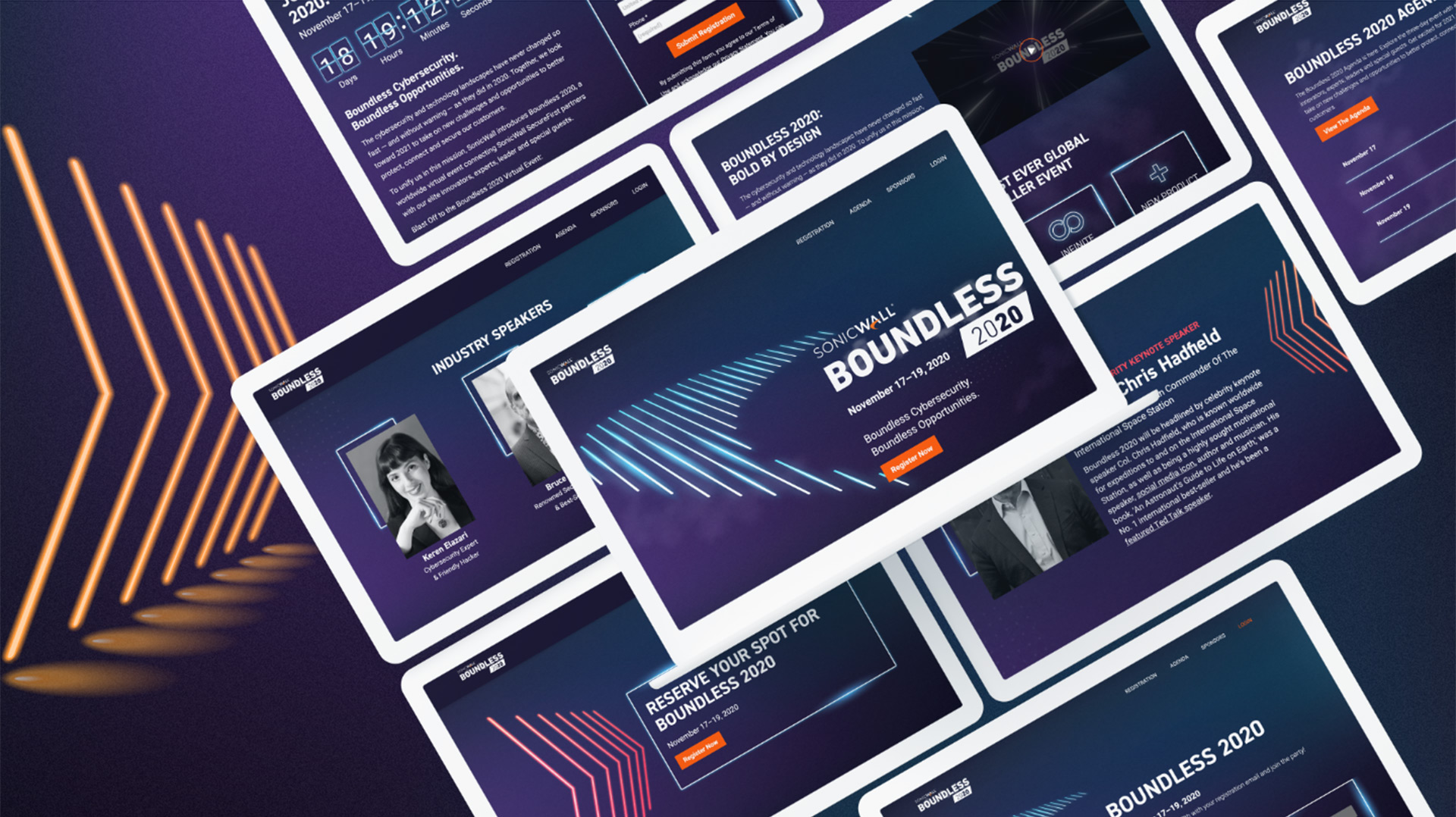 3. Augmented Reality
3. Augmented Reality
For a few years now, brands have been experimenting with augmented reality to help place their products directly in front of their potential customers. For example, Wayfair and other furniture companies have an augmented reality feature that places a new piece of furniture directly in your space, allowing you to see how it would fit before making the purchase. Warby Parker leverages augmented reality to show consumers how a new pair of glasses may look without going into the store to try them on or waiting for their at-home try-on box to arrive.
Augmented reality truly allows brands to revolutionize the way consumers interact with their brands, and ultimately their products. And if you’re thinking, ‘that’s neat, but only for flashy consumer brands’ you might want to think again. B2B companies are adopting and innovating on the trend to make this technology applicable to their offerings. Because, why let consumer brands have all the fun?
Bluetext worked with AppGate to provide an immersive augmented reality experience at RSA® Conference 2020, the world’s leading information security conference in San Francisco. Bluetext conceptualized, designed, developed, advertised, and coordinated the ground-breaking Kill Your VPN campaign and augmented reality booth experience to help AppGate stand apart from the 658 other exhibitors in 2020.
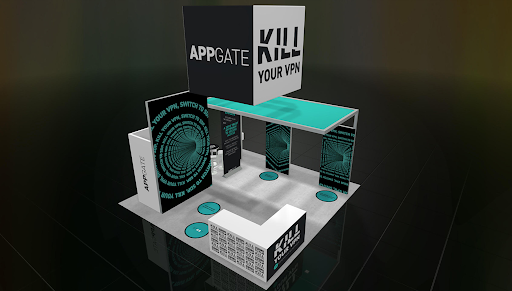
4. Content from Micro-influencers
The influencer marketing industry was worth $8 billion in 2019, and it is estimated to grow to $15 billion over the next two years. But according to Kali Ridley, a marketer on Google’s Brand Studio team, the future lies not with megastars and their millions of followers; it’s with micro-influencers.
Micro-influencers are those with smaller followings, somewhere between 1,000 and 10,000 followers, who are able to form a community within their reach and share messages that will resonate with their fans. More and more, marketers are discovering relatability outshines star power. Relatability feeds directly into trust, therefore, creating a much stronger argument for your product or service.
LinkedIn has undoubtedly made changes to its platforms that enable these micro-influencers to make a further impact. The new “Creator Mode” for LinkedIn allows users to pin specific hashtags to the top of their profile to signify the themes they frequently post about. With creator mode enabled, the presentation of profiles is altered to emphasize the hashtags directly under job titles. Additionally, users can “Follow” these influencers rather than adding them to their personal networks. Now instead of feeling uneasy sending network invitations to a complete stranger, users can follow their favorite thought leaders just as easily as on other social networks.
These small changes in the social media platforms signal that micro-influencer marketing strategies are worth the investment and aren’t going anywhere anytime soon.
If you want your brand to stand out and succeed today, and tomorrow, consider getting in on any of these trends. Each of the four above have a promising future of long-term success. As a digital marketing agency, Bluetext expects these trends to be adopted by many companies over the coming years, and only improve with iterations on previous success. Contact Bluetext today if you’re interested in a future-focused marketing strategy.
Have you ever searched for a term or product, then had to wade through a sea of ads before you could find what you were looking for? What’s even more frustrating is seeing the same ads over and over again. As a social media firm and B2B marketing agency, Bluetext knows there’s a fine line between getting your message in front of users and overdoing it.
Ad fatigue, the term for “when your audience sees your ads so often that they become bored with them and stop paying attention,” can be costly and can make your advertising ineffective. Over the years, as a social media firm and B2B marketing agency, we’ve found several of the most effective ways to avoid ad fatigue. Keep reading to learn 4 ways you can avoid wasting your paid media budget:
1. Decrease Ad Frequency
The best and most obvious way to decrease ad fatigue is by limiting the number of times a user sees your ad. Unless you place a frequency cap or have an audience of millions, advertising platforms will continuously serve your ads to the same users. For the user, this can be frustrating and can even turn them away from your brand. In fact, AdEspresso conducted a study to see the impact of ad fatigue on Facebook and found the following results:
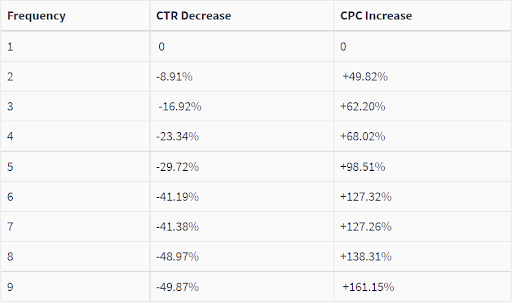
In this study, as frequency increased, CTR decreased and CPC increased. Of course, there is no one size fits all approach to frequency; that said, however, through our time as a B2B marketing agency, we recommend making changes if frequency surpasses 4 or 5 on Facebook.
2. Refresh. Refresh. Refresh.
Another great way to reduce ad fatigue is by updating your creative frequently. By doing so, users get to see fresh ads all the time. Your company and message may remain the same, but a new visual approach will catch the eye and give the impression of a new, shiny nugget of content. If you don’t have the resources to constantly update your ad creative, something as simple as adjusting the description text, links, or CTAs on Facebook, LinkedIn, and other social platforms can help refresh your content. Otherwise, a social media firm, like Bluetext, can be a helpful resource for achieving scalable creative production.

3. Test Your Audiences
One of the most important ways to optimize your creative and reduce ad fatigue is by A/B testing your creative. From CTAs to copy, A/B tests can vary in goals. It’s vital, however, that you run the test for long enough to reach a large enough sample size. Using a sample size calculator is the best way to ensure your audience is large enough to reach statistical significance.
4. Create Custom Segments
By creating custom audience segments, you can exclude users who have already completed the desired action on your landing page. In turn, you can avoid overwhelming users and make sure you’re spending your media dollars as efficiently as possible. With custom segments, you can also create retargeting audiences. With specific retargeting and dynamic creative, you can serve customized content to users based on their previous search queries and interests.
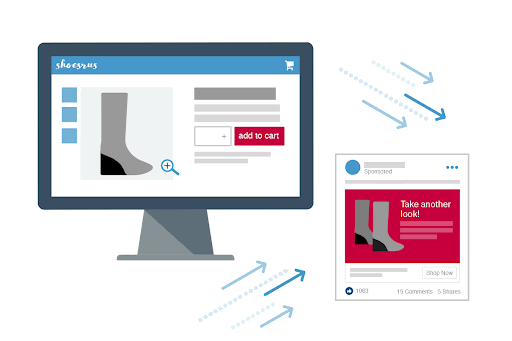
Needless to say, ad fatigue negatively affects campaign performance by increasing CPCs, decreasing CTRs, and frustrating users. Taking steps, like the ones listed above, to combat ad fatigue will ensure you are spending your money efficiently and keep your audience engaged.
Interested in working with a social media firm and b2b marketing agency to ensure your ads have a positive lasting impact? Contact us here!
Mergers and acquisitions occur every day, but are they setting their companies up for success? One of the challenges with M&As is ensuring your company’s values remain clear in your brand’s image. Customers need to be assured that their service won’t change, but rather improve. Bluetext, as a full-service marketing agency, has a proven track record of helping companies navigate complicated integrations while increasing their overall value.
So your company went through an acquisition, why should you rebrand?
In any acquisition, companies are left with the challenge of combining two or more entities with different brand values. While acquisitions often enable companies to expand or improve their service, customers will inevitably remain skeptical until they see their trusted service remains up to par. Bluetext has the acquisition marketing knowledge to guide your company through a successful acquisition. By focusing on marketing from the start of your acquisition, you can seamlessly align previous companies’ brand values to a new, better than ever entity.
After the private equity firm GTCR acquired Sage Payments, they came to Bluetext to re-design and launch Paya, their joint venture. The initial launch was slated to create a simpler payment system for users but left much to be desired by their parent brand. Bluetext helped create a new corporate Visual Identity (CVI) that conveyed the essence of partnership. We conducted a logo study to find a logo that would convey the user-friendly nature of Paya while establishing it as a payment company. Additionally, by utilizing a dual-journey hero, we were able to satisfy two different customer needs while providing a unified site experience. Learn more about Bluetext’s brand development agency work in our Hall of Fame.
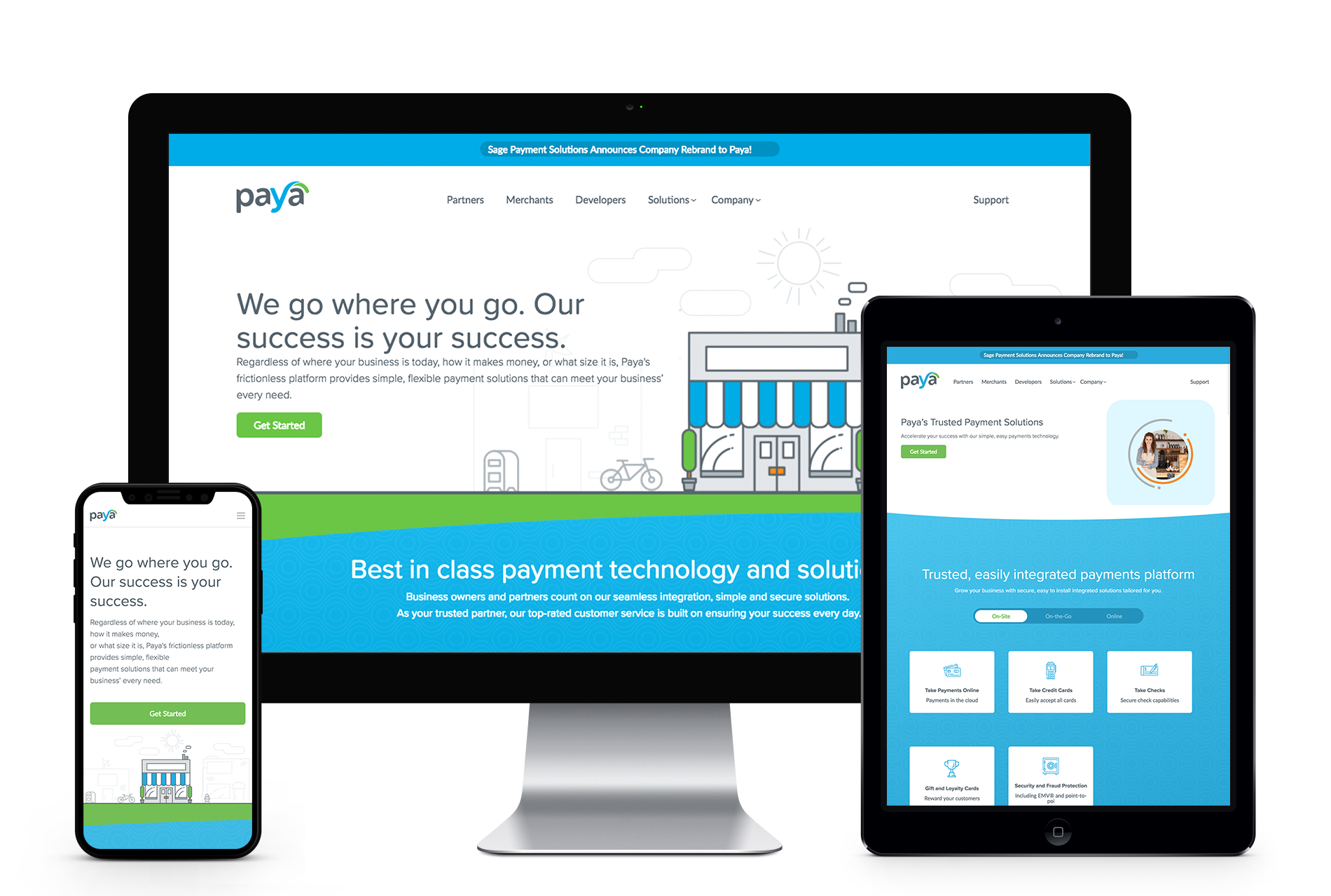
When Integrity Applications Incorporated was acquired by Arlington Capital Partners, they came to Bluetext as a trusted brand marketing agency to help launch their unified brand, Centauri. Opting for an approachable logo, we designed a custom lowercase typeface for Centauri that evokes a modern feel, complemented by a logo based on the Centauri constellation. Combining these visual elements helps establish Centauri as a trusted security company. To ensure all of this was successfully received by their customers, we launched a go-to-market campaign that encompassed PR, digital advertising, and social media.
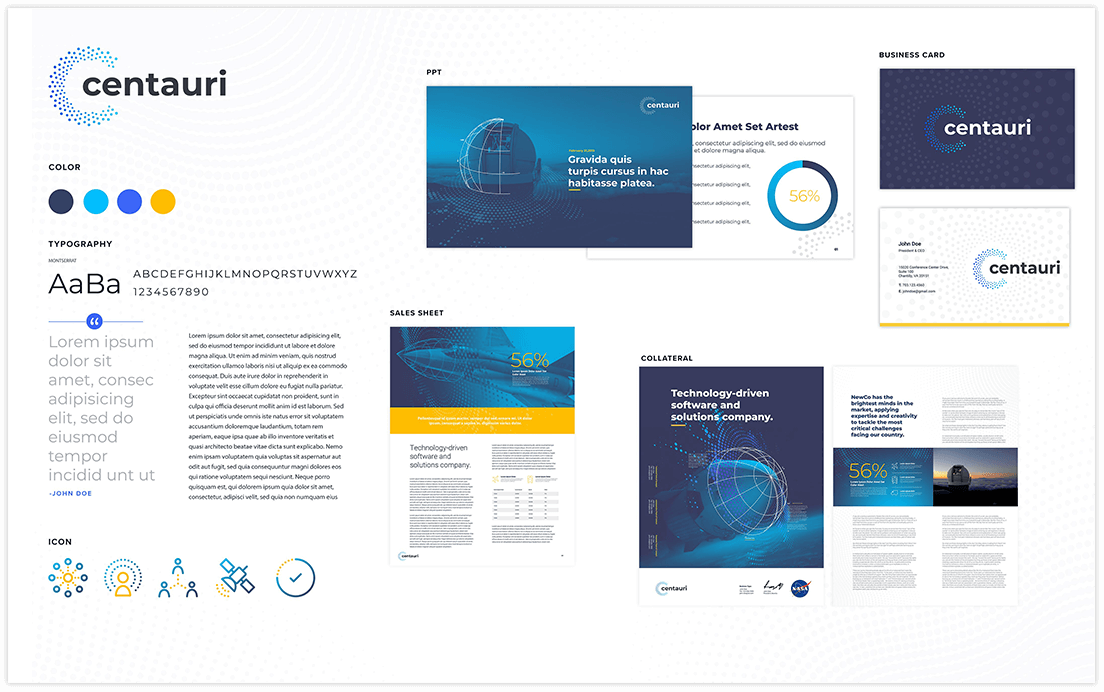
How will new branding affect your business?
As with any change, it’s important to manage expectations. With our help, we can create a strategic plan to proactively reach out to your customers and explain any management changes at the brand launch. Set your customers’ minds at ease by letting them know what to expect from the merger. Energize your employees with the promise of the new brand, with everything from new corporate messaging to branded collateral. Geared with all the right communications tools, they can feel confident reaching out to customers and stakeholders on how the merger can benefit them. Beyond setting expectations, your new branding can build a stronger relationship with your customers. Kristopher Jones highlights the importance of leveraging your branding to connect with your customers on a more human level.
At the end of the day, change is tough — but necessary. To navigate a merger or acquisition successfully, partner with a digital branding agency that can guide you and execute your branding plan from day 1 through completion. If you want to minimize the growing pains and maximize the end results, get in touch with us to help develop your acquisition marketing strategy.
17 hours—that’s how long the average person spends looking at a screen each day. With remote learning and work-from-home, screens take up our attention and are expected to remain an integral part of society long past the pandemic. That’s why getting a jump-start on digital curated content marketing is more important than ever. What is content marketing? In simplest terms, it is consciously selecting valuable content to be shared with your targeted audience. In order for content marketing to be successful, it must be relevant and up to date. It takes time and effort to keep up with changing trends within the marketing mix, which is why Bluetext has provided 3 ways to make the most of your content marketing efforts below. Quality content marketing can keep your business ahead of the competition, at a lower cost compared to other marketing strategies.
3 Must-Have Strategies to Capitalize on Your Content Marketing:
1. Virtual Engagement
As the pandemic shifted business online, working Americans realized they could have just as productive a meeting from their homes as in the office. It proved that even if that meeting could not have “just been an email”, it could be virtual. Turns out, there’s really no need for employees to sit in hours or traffic or fly across the country in order to get things done. Social norms pivoted quickly, as it became standard practice for not only meetings to be conducted virtually, but also events. Webinars, Zoom happy hours, and virtual conferences became the norm as companies shifted operations to accommodate a virtual world. While there are some pros to an online environment, there are also undeniable cons. We stare at screens for hours on end, making it difficult to stay focused and engaged. By the fourth zoom login of the day, we get bored and lose interest. In order to improve the digital experience, businesses should be conscious of content quality and delivery methods. Due to the pandemic and the shift to virtual, the bar for content marketing has been raised. Every piece of content marketing should be curated to not only promote your brand but also spark engagement. Breakout sessions, polls, live-chat, animations, and other interactive elements are great ways to maintain engagement with your participants.

2. Influencers/Brand Ambassadors
While people were isolated in their homes, they used Social Media to stay connected during the pandemic. Platforms like Tik-Tok, YouTube, and Instagram experienced an increase in usage, creating the perfect avenue for digital marketers. Social Media Influencer marketing increased worldwide, as consumers related more to their favorite blogger on their personalized Instagram feed rather than the A-list celebrity featured on TV. Content produced by influencers helps to fill in the gaps of content coverage by creatively reaching the target audience in a more natural way. This trend extends far beyond the promotion of consumer products, as B2B industries have recognized the power of influencer marketing across a number of social platforms. Within the B2B marketing landscape, employees can serve as influencers or “ambassadors” for your business’s brand. Your employees are typically connected to more people on social media than your brand. While taking advantage of strong ties, employees are able to communicate messages to a target segment with strong content marketing.

3. Search Engine Optimization
When you view Google search results, how far do you scroll down the page? Not very far. Users typically do not make it past the first few search results, which is why it is critical for your business to dominate SERPs (Search Engine Result Pages). Businesses need to invest in SEO if they want to optimize their revenue goals. SEO is an ever-moving target, as digital marketers must leverage analytics, employ automation, and keep up with Google’s latest algorithm updates. Frequent publication of content marketing rich with keywords is one of the top recommended strategies to stay on top of SERP results. Not only is the optimization of your keyword strategy important, but also the digital web experience attached to your site. Given that users’ attention spans are short, your business’ website must be engaging and easily navigable. Since we are always on the go, marketers should also capitalize on mobile SEO abilities. On average, people are on their phones for at least 6 hours each day, therefore an easy-to-use mobile platform is crucial to reach audiences. Plus, enhanced mobile speed & experience is new criteria strongly weighted by Google Web Vitals. Overall, prioritizing the user’s website and search experience will yield better results.
As you have learned, curated content marketing is critical to take your business to the next level. Contact Bluetext if you’re interested in revamping your B2B content marketing strategy.
When you think of your business’ data, what is the first thing that pops into your head? Graphs, charts, and databases? Spreadsheets filled with row upon row of figures waiting to be put to use? While all of these things are important to your business’ data structure, they’re only individual parts of an extensive data ecosystem, an understanding of which is critical. Data ecosystems provide companies with reliable data to understand their customers and to make better pricing, operations, and marketing decisions.
What is a Data Ecosystem?
A data ecosystem is defined as a collection of infrastructure, analytics, and applications used to capture and analyze data. These applications collect and filter information for businesses to better understand their users, website visitors, and audience members. The term “ecosystem” is used because data ecosystems are dynamic and expected to constantly evolve to accommodate the changing needs of your organization.
At their core, data ecosystems are used to capture data and produce meaningful insights. As customers use products, especially digital ones, they leave behind data trails. By creating a data ecosystem, companies can catalog and analyze data trails so product teams can better understand user preferences. The best data ecosystems are constructed around a product analytics platform that enables teams to integrate multiple data sources, provide machine learning tools for automation improvements, and track user cohorts to simplify calculating performance metrics. Additional applications that analytics platforms empower include increasing user engagement, increasing user retention, and conversion tracking and marketing funnels.
Creating a Data Ecosystem
The three essential elements of a data ecosystem are infrastructure, analytics, and applications. Infrastructure can be thought of as the foundation on which everything else is built. It’s the hardware and software that capture, collect, and organize data, including servers for data storage, search languages like SQL, and hosting platforms. Analytics serves as the entryway that teams use to access their data ecosystem. Analytics platforms sift through and summarize the data within the infrastructure, so all data is visualized in a centralized place. At this level, an organization can segment users and measure them with marketing funnels, identify the traits of ideal buyers, or automatically send in-app messages to users who are at-risk for churn. Finally, applications are the individual components of the ecosystem, the services, and systems that act upon data and make it usable. At this level, users can work with their analytics data to drive critical outcomes across the organization, like a marketing team drumming up leads based on activity or a sales team tracking key user engagement. Finally, applications are the individual components of the ecosystem, the services and systems that act upon data and make it usable.
Optimizing Your Data Ecosystem
There is no one-size-fits-all approach to optimizing your business’ data ecosystem. There are, however, two concepts you can keep in mind as you work towards the right fit; democratizing your data science and establishing strong data governance. A key benefit of good data management is that everyone has the ability to access reports and insights. By democratizing your data and purchasing a large number of licenses for your analytics software, rather than restricting access to only a few employees, you can prevent bottlenecks in the flow of information and promote a frictionless exchange of information. That’s not to say that you should leave everything unbound, however. Setting rules and boundaries for employees about collecting, protecting, and accessing data is essential for shielding your company from liability and complying with federal laws about privacy protection. A marketing analytics agency, such as Bluetext can assist with prescribing the right data ecosystem tailored to your organization’s needs.
Impactful Outcomes of a Data Ecosystem
For an organization to remain competitive in any industry, they have to have a comprehensive understanding of their data. Understanding your company’s data ecosystem is the first step towards segmenting your user base, learning who they are, and revealing how they interact with your business. Informed decision-making at every level of an organization stems from understanding and engaging with its data ecosystem.
It’s no secret the digital marketing industry depends upon and craves data. Any piece of information gathered about a user can be used to strengthen your lead generation, campaign or website strategy. While every digital marketer is hungry for data, there is no value without context and robust understanding. Marketing analytics can and should be used to inform, as well as validate any digital strategy.
Contact Bluetext if you’re interested in turning analytics into action.
20 times a day — that’s how often people on average check their email. Sounds like a lot, but in reality emailing has become so ingrained in our everyday routines. Whether email is the first thing you check when you wake up, in line at the coffee shop, or multiple times during the workday it is a key aspect of our personal and professional lives. Hence, the importance of email marketing. Seems like a no-brainer–sales and marketing outreach is a natural fit for email inboxes. So why are your email performance metrics dwindling?
The prevalence of emails is a double-edged sword. Yes, email is an undeniably popular form of communication. However, this means inboxes are being constantly flooded. On average people receive 121 emails a day. This heightens the challenge of effective email marketing but does not dilute the significance of email marketing. It’s the most popular channel for business communications and the reliable channel for nurturing and converting leads to sales throughout the funnel. Many It is a tricky, but highly rewarding digital marketing platform. The nuances of email marketing and widespread frustration with stagnant performance metrics have led Bluetext to identify the 5 most common email marketing mistakes and how to improve your email performance metrics.
1. Subject Line Skepticism
One of the most challenging aspects of email marketing is the subject line — this is the hook that entices a user to either open your message, or ignore it entirely. When your inbox is being constantly flooded with marketing emails it can become second nature to simply ignore or mark a promotional email as spam. However, a strong and attention-grabbing subject line can dissuade a user from these practices and pay attention to your messages. Below are some of the most common subject line faux pas:
- Too wordy – your subject lines need to be short, sweet, and pack a punch. Think about all the words on your average inbox interface, there’s a lot! In a 5 second scan, your subject line should jump out with concentrated keywords. The highest open rates occur with subject lines 6-10 words in length. This keeps the full message readable in the line item without truncating with those dreaded … A subject line doesn’t need to contain entire sentences, or detail every piece of content inside. Instead, try a catchy phrase or question to spark curiosity, which instantly drives engagement.
- SPAM Red Flags – subject lines written in all caps immediately sound the alert for SPAM filters – both by the reader and email system!
- Pre-Header Connection – subject line and pre-header text are two key elements of any email that when used effectively form a dynamic duo. Both are prime opportunities to capture attention and prompt an open, thus need to complement one another. Strive for subject lines that briefly describe what the message is about, and a pre-header provides important context. Together they form a cohesive narrative that gives a sneak peek, driving the reader’s engagement.
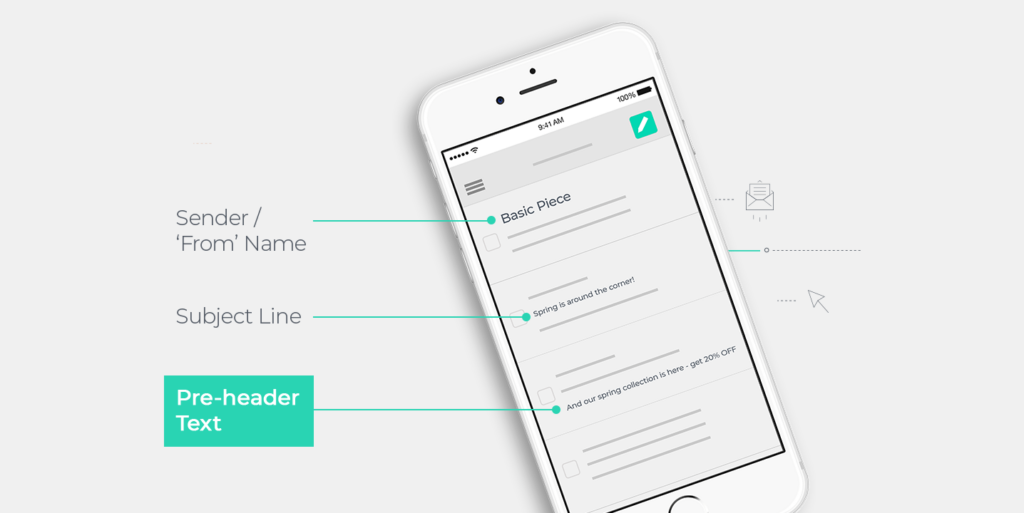
2. Forgetting the Filters:
Keep in mind the success of your email marketing campaign hinges on two parties: the recipient and their email provider’s SPAM filters. More often than not marketers concentrate on the human reader and forego considerations of the automated filter system. To avoid getting trafficked to SPAM folders, watch out for the use of these warning signals: clickbait phrases, all caps, overuse of “you” and “I” pronouns, and listicles. Email providers most commonly scan content on the following levels:
- Header filters – look for spam indicators in email subject lines and pre-headers (for example clickbait phrases, all caps)
- Content filters – crawl the content of the email to find spam indicators
- General backlist filters – use the database of spammers to determine if the email is clickbait
- Permission filters – ask the reader for confirmation before opening the email
3. Over Genercism:
Personalization is key and leads to 25% higher open rates. In any aspect of digital marketing, it’s important to recognize basic human psychology: people want to feel special. Whether that’s by seeing their pain points addressed, persona-based navigation, or even as basic as being addressed by name. Personalizing emails with first and last names is a simple, but effective way to grab the reader’s attention and qualm the suspicion of copy-and-paste clickbait. Additionally, the overuse of first-person pronouns is a trigger for SPAM filters. Consider adding their name to a subject line (ex. John, your system needs updates” or at the least beginning the body copy with a personalized greeting “Hi John Doe,”. With this approach, your email immediately feels like a one-to-one conversation and less of a robotic one-to-many outreach.
4. Unclear Call-to-Action:
Let’s backtrack: the goal of your email is to guide your subscribers from opening an email to going to a landing page where they can learn more information about a promotion, request a demo, or contact you. Your email marketing strategy is aimed at turning leads into prospects, and eventually customers. Getting users to open your email is half the battle, the other half is guiding them to conversion. Don’t make a reader dig through email content to find the end goal. Add a CTA or landing page link to the beginning and end of an email body, in the event that the user does not read the entire message. A CTA stands for “calls to action” for a reason — they should be action-orientated and exciting! Experiment with different language that goes beyond the boring “Learn More” to inspire clicks. Perhaps try a stylized button to really catch the eye. The most important aspect is to be cautious of burying your CTA, if it can’t be found in a 5-10 second scan chances are your reader will give up and forgo the opportunity.

5. Ignoring the Technicalities:
Before getting into all the bells and whistles of your content strategy, set yourself up for success with a strong foundation. Deliverability of your emails is crucial to getting your foot in the door with your messages. About 10% of emails never even reach inboxes due to bounces, SPAM filters, or other technical issues. Most email service providers (ex. Marketo, Pardot, HubSpot) systems have built-in functions to assist with technical evaluation of domain authority, IP reputation, and email testing before you hit send. On a regular basis, you should be checking the health of your email systems, removing inactive subscribers, and analyzing important deliverability & bounce metrics.
As you can see there’s a lot to consider within your email marketing strategy. It’s a tricky path to navigate, but when done right, is a powerful digital marketing tool.
Need to uplevel your email marketing strategy? Contact Bluetext to learn more about our services.
After crafting the perfect campaign, ad creative, and hook-worthy copy, there is nothing more frustrating than a user coming to your website only to leave after a few seconds.
In order to prevent those high bounce rates and low clickthrough rates, you need to set up engaging and informative landing pages that lead visitors to the actions you want them to take on your website. It’s not an easy task, but thankfully digital marketing agencies, such as Bluetext, have experience and tips to share. Let’s look at five ways you can master the art of the landing page.
1. Emphasize Calls to Action
As this Elementor article states, “Unlike most webpages, landing pages often actively discourage exploration in an attempt to push visitors toward the CTA.” The whole goal of your landing page will be to push your users to a certain action or link, so make sure you place CTAs throughout your landing page to encourage clicks as the user scrolls. Also, be certain the CTAs are the most prominent component of your landing page, by color, placement, or other characteristics, they need to stick out to grab visitors’ attention and entice click-throughs. Also consider adding sticky CTA menus that follow the user down the page, enticing them to click-through at any time during their experience with your site. Some top placements of sticky CTAs lock onto the right-hand side or directly under the main menu navigation.

2. Think Through Your First Viewport
When a user first appears on your landing page, they are looking for an immediate answer to their question. Every one of us has looked at a website for all of one second before exiting because we could not immediately find the information we wanted or perhaps there was too much text to read through.
Make sure that you use that first viewport wisely to start appealing to user needs. Have informative, relevant headlines, eye-catching images or video, and helpful secondary text. All of these pieces will go a long way in convincing your users to continue to scroll, and eventually click that CTA button.
3. Write Intriguing Copy
If you can grab your visitor with their first look at your landing page, you’ve already overcome a significant challenge of landing pages. However, now you need to sustain that attention. It’s a tricky maneuver, balancing providing immediate information while also ensuring they absorb additional details. Give everything away at once and the user never interacts further with your website, but tease it out too long and you risk users bouncing off the page. Digital marketers recommend to not overwhelm the user with small, dense text but instead offer answers to their questions. Additionally, psychological elements can be used to reach your visitors and convince them to use your CTAs. By the time someone finishes reading your landing page, they should have a clear idea of why your product or service will give them the best solution to their problem.
4. Optimize for Search Engines
You may have the most magnificent landing page in the world, but that does nothing if people can’t find it. Using keyword phrases and writing rich meta descriptions is an important part of SEO for a successful landing page. By getting to the top 20 results of Google (or in the first two pages of results), the chances of someone actually seeing and clicking on your landing page rise substantially.

5. Design with Your Users in Mind
As with any page, design can make or break your user experience. As you write copy, consider what information is most important to the user and needs to be emphasized in valuable H1’s and H2’s, think about which details could be shown in more interactive formats, and choose media that adds to instead of distracts from your main purpose. You also need to ensure that your landing pages are fully accessible for all your potential users.
A great example of a compelling, successful landing page comes from our campaign with Varonis. Bluetext worked with Varonis to create ads that drove viewers to landing pages and CTAs. By targeting the right audiences and leveraging intriguing copy, Bluetext helped Varonis grow its click-through rates above the industry benchmarks.

Want to learn more about creating successful landing pages or are interested in working with Bluetext to create a successful, data-driven landing page strategy? Contact us today.
In our recent blog post, we discussed the power of strategic branding in the world of private equity. As we mentioned, the first step in developing a new brand for an M&A should be to gain understanding and consensus on how you want to be (and can/should be) positioned within the market via your company messaging and positioning. Once you have the words right, it’s time to get the looks down. Your company CVI (corporate visual identity) includes the logo, the color palette, typography, graphics and iconography, unique branded elements like an image masking or pattern overlay, and so much more. As we stated before, you only get to go to market with your new brand once – make sure it counts by following our steps to a successful M&A brand launch below.
3. Define the New Company Structure
When merging multiple companies, it’s important to think through the new structure, from multiple points of view – the employees’ roles, the products/services/capabilities, the customers and partner channels, the company values and culture, just to name a few. Understanding and clearly communicating how everything will fit together will help employees adapt to the change and ultimately help the brand strength. Ideally, you should already be thinking about this during the messaging and positioning phase and should have an idea of what’s overlapping, what’re the new capabilities that need to be accounted for, and write new content for? How do they fit into the company story and how do you market them? How does this affect the website’s sitemap, content, and user journey? How does this affect current and new contracts?

Understanding the company’s new structure and thinking about new processes early on makes it easier to design around the new information architecture, flag problem areas that employees or customers might be confused about, and address them before it becomes a challenge. It’s also beneficial to look ahead – many times during an M&A, companies might be in the process of acquiring another new company/companies towards the end of when they’re launching the new brand. Accounting for that potential while thinking about the new company structure and information architecture encourages a scalable structure knowing that the company’s solutions and capabilities will likely continue to expand throughout the process of building the new brand.
4. Plan Your Internal & External Go-To-Market Campaign
Now that you have strategic messaging and positioning, a new corporate visual identity, and a good understanding of new company architecture, it’s time to start planning the launches – both internal and external go-to-market campaigns.
Employees are brand ambassadors, so set them up for success with a smooth internal launch by setting expectations and communicating in a clear way how this change will affect their roles/responsibilities, the culture/values, etc. Employees are looking to understand what this change means for them. How is their job changing, what’s the new org chart, who do they report to, how do they refer to the brand, etc? A personal touch like a letter or video from the CEO can go a long way in delivering a level of unity and excitement about the upcoming changes. Prep them with swag bags of new branded merchandise, prepare a digital brand assets package with all new branded collateral templates like pitch decks/presentations, datasheets, white papers, business cards/stationery, email signatures, brand guidelines on how to use and apply the new branding, etc. A well synced internal launch promotes confidence about the new company and its opportunities, and the employees are an extension of the brand, so preparing them and motivating them for the changes to come are necessary for the brand to hold strong internally before launching externally. The better you communicate to and prepare employees, the stronger the brand will be represented through them.
A compelling Go-To-Market campaign is essential for an external brand launch. This includes everything from PR and media outreach, to ensuring the website is ready to launch, to a strategic paid social campaign with PPC, hyper-targeted ads, geofencing, marketing automation with email campaigns, optimized SEO, and maybe even a brand launch or brand essence video to really stand out and help tell your story.
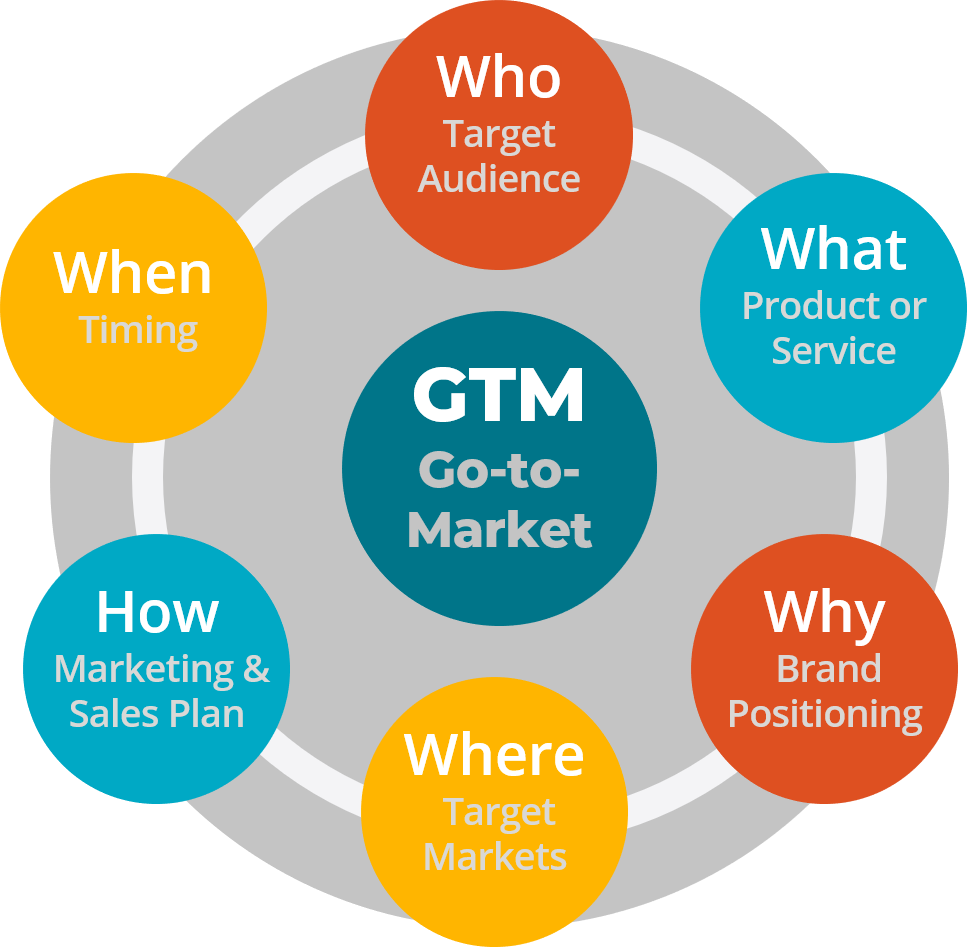
The GTM campaign is where everything comes together – the messaging and positioning weaved in the campaign theme, the compelling visuals representing the new corporate visual identity, and the excitement around the new company’s capabilities and what this means for customers. Executing on a strong go-to-market campaign is not only critical in getting brand awareness, but also in driving home the value of being stronger together – both internally and externally. It’s not about the change; it’s about what’s next, together.
Case Study: SpaceIQ
Enter three leading brands of the workplace management industry: SiQ, Archibus, and Serraview. Each with a rich product portfolio with distinct features, designed for the needs of different sized companies. United, they offer integrated workplace solutions that optimize the workspace and enhance employee experience for companies of any size. Project Union became the name of this powerful merger of three companies into SpaceIQ, a comprehensive solution on a mission to make the workplace good for business and great for people.
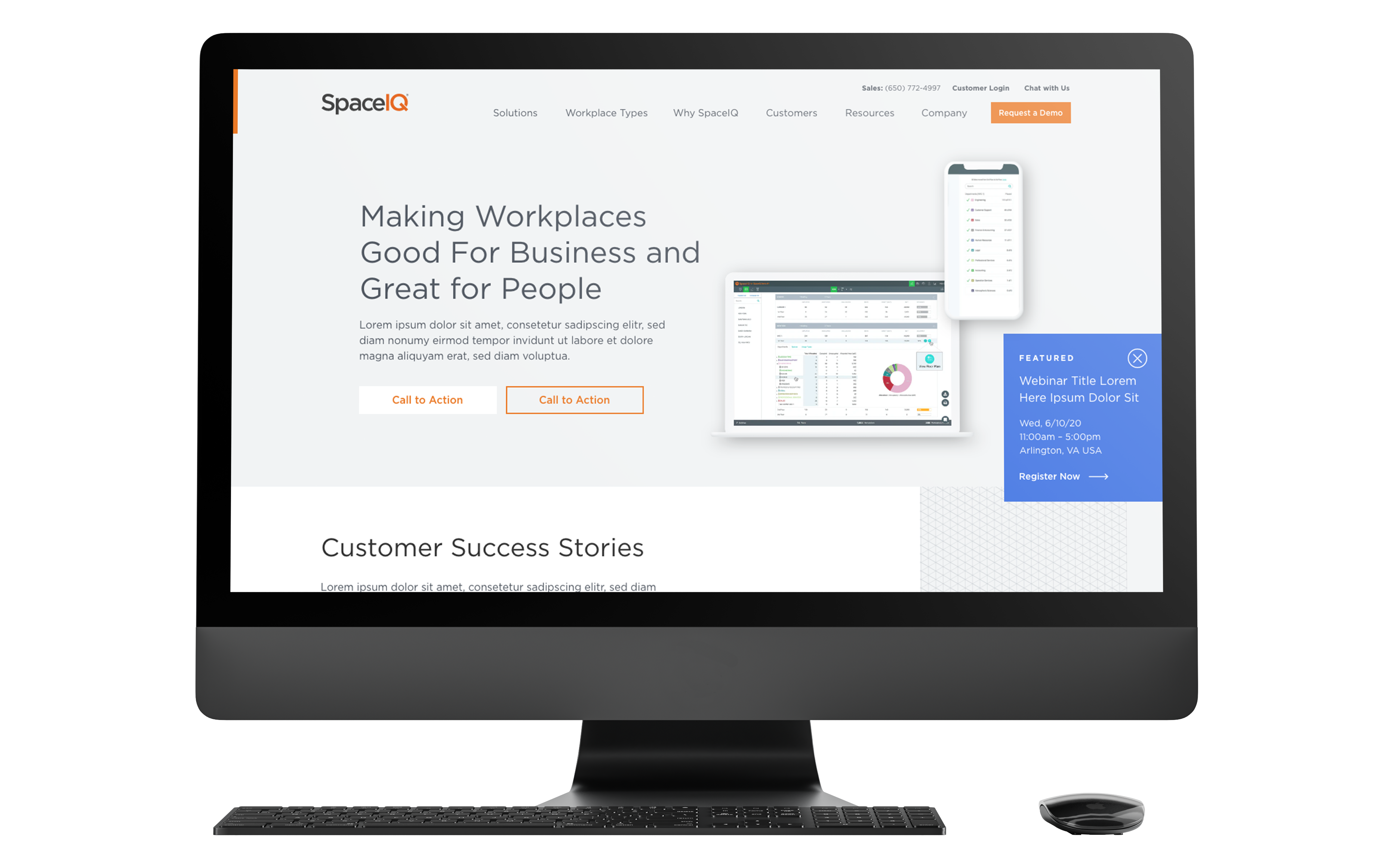
To solidify the merger, SpaceIQ needed a new website that spoke to its breadth of offerings and united company mission. The company turned to Bluetext to turn their new branding into a fully responsive and intuitive website to communicate all of their product lines. The new site was designed with the end customer needs top of mind. Using dynamic components to showcase success stories, custom glossary pages, and a robust resource center for all post types, SpaceIQ customers can easily find all the educational resources they need. The three legacy brands’ relevant products are clearly identifiable through the sitemap and component features, but balanced by cohesive branding and streamlined user journey.
5. Keep It All Going
Finally, keep the momentum going, and even ramp it up! The early stages of launching a new brand from multiple companies require a lot of time, energy, and effort to maintain the excitement and continue to push brand awareness. Also from a technical perspective, there are things to consider like not immediately redirecting all legacy websites to the new site since a lot of content, like contract vehicles, for example, needs to still be accessed. However, it should still be obvious that it’s now a new company – so adding homepage banners on legacy sites with the brand launch announcement, or updating logos on the legacy LinkedIn pages (but not removing them), can help make the transition easier for customers until the brand has had time to fully establish itself in the market and stand on its own. SEO is another area that requires some time and love to see improvement since it’s likely a new name and some new search term combinations that google is processing.
A company is only as strong as its talent, so maintaining and recruiting top talent should be a priority. Consider starting a series of video vignettes with current employees speaking about their time at the legacy companies and how it’s been at the new company. Why do they love it, what makes this company different from competitors, how are there more opportunities now, etc.
Along with recruiting campaigns, continuing to execute strategic brand-awareness campaigns via paid and organic social, continuous content writing for SEO and thought leadership, etc. is a long-term game that’s critical in moving from brand awareness into more specialized branded experiences that will resonate even more with the market.
The stronger the M&A brand launch is, the easier it is for PE firms to sell
The most important thing to address in an M&A brand creation is the why (aka, the value prop) behind the new brand and set clear expectations of what this means for employees and ultimately the market. What new, innovative outcomes can we enable? Prove the value proposition of being better together. If you can get the employees and your target audience on board with the new mission, it becomes less about corporate changes and transactions and more about the new opportunities that arise from being part of this new market-dominating company. And when the portfolio companies succeed, the PE firms succeed. For PE firms, having a strong brand itself, as well as a portfolio of strong brands, is crucial for deal sourcing, fundraising, and ultimately achieving higher investment returns.
A brand is often considered a company’s most valuable asset – make sure it’s in the right hands.
If you’re looking for expert strategy and implementation for your next M&A brand launch, you’re at the right place with Bluetext. We know a thing or two about M&As. 40 of our clients have been acquired within 24 months of an engagement with Bluetext. See some examples of our work with these M&As here, and contact us to get started.
PE firms need portfolio companies with strong branding
Private Equity (PE) continues to be the preferred growth financing mechanism for most “for-profit” businesses. According to McKinsey’s 2019 Market Annual Review, “global private equity valuation has grown more than sevenfold since 2002” – more than twice the growth of publicly held equity valuation. While PE fundraising declined in 2020 to the Covid Pandemic, PE markets are experiencing a strong increase in 2021.
PE firms make most of their profits by acquiring companies, helping management increase Enterprise Value through various strategies, and then selling these companies at a much higher value. Value is quantified using metrics such as Earnings (typically EBITDA – Earnings Before Interest Taxes Debt and Amortization), Earnings Multiple (a factor applied to EBITDA to determine Enterprise Value), and valuation of Intellectual Property.

A common and highly effective growth strategy for PE portfolio companies is buying competitive or complementary companies through Mergers and Acquisitions (M&A). The brand is almost always a key component of a) the Earnings Multiple and Intellectual Property Value metrics in the valuation process and b) a successful M&A strategy. Here’s why.
Branding is so much more than a name and a logo; it’s a representation of how your company is perceived – more specifically, how your customers and the market perceive you. It’s a gut reaction, a feeling. This is why it’s critical prior to going through an M&A to create a strategic, memorable, and unique brand that provides a consistent experience across all channels, and makes sense to not just the market, but to all employees, as they become brand ambassadors themselves. PE firms have many tools and metrics to measure the value of a brand (brand loyalty, recognition, and impact) which drive a monetary valuation.

Sloppy, outdated, or inconsistent branding can make employees and the market feel uneasy and unconfident with the new company. A powerful, cohesive brand right from the gate is essential in sending the right message of being “stronger together.” In addition to looking the part, strong brands are more profitable, grow faster, and sell more frequently. You only get to go-to-market with your new brand once – make sure it counts by following our steps to a successful M&A brand launch below.
Our steps to a successful M&A brand launch
1. Develop New Positioning & Messaging
A strong brand is designed to dominate the market, which is why the first step in developing a new brand for an M&A should be to gain understanding and consensus on how you want to be (and can/should be) positioned within the market. You need to understand where you could be within the market as this new company with more talent and more vast capabilities. Determine how all the current brands’ are currently perceived, vs. how you want to be perceived. What are the brands’ value propositions and how will they be combined? If possible, involve your target audience via surveys or workshops to understand how the companies are perceived. That knowledge is a baseline on how all the companies are perceived in the market today and what needs to change in order to be perceived differently and help set expectations.
Once those baselines are understood, you’ll want to define a specific positioning strategy then base your new messaging off of that. With combined capabilities and potentially different focus areas, the positioning strategy likely will shift, so you need to identify how it should shift and define clear and compelling differentiators early on that the positioning and messaging are based on.
Market your new capabilities, but don’t become a generalist. By combining two (or frequently, more) companies together, it’s obvious there’s more diversity and broader capabilities, but if not done the right way, growing this list can make you seem too generic or disjointed. You don’t want to come across as a “jack of all trades”, but rather, a “specialist of many.” This is why considering not just the increased amount of advanced capabilities, but the outcomes of those capabilities and communicating that clearly and effectively in the new messaging is critical.
2. Create New Corporate Visual Identity
This is what most people think of when they hear “brand”. Corporate Visual Identity, CVI, is how a company visually portrays itself to the public. The logo, the color palette, typography, graphics and iconography, unique branded elements like an image masking or pattern overlay, etc. all work together to form the CVI.
Merging a brand portfolio is challenging, and there are several factors to consider before creating a new CVI. If you’re not going in the “house of brands” direction where the parent company is not associated with the products, then you’ll want to develop a unified CVI that is unique in the competitive landscape, is compelling and memorable, and visually represents the story you want to tell from the messaging. Some questions to consider include:
- How do customers/the market connect with each of the brands?
- What is the brand equity of the company or companies in consideration?
- How will you decide which assets, if any, to retain from each brand impact projected revenue?
- What story are we trying to convey and how can we visually portray that?
M&As set many new paths for success, but if the new company’s Corporate Visual Identity is not unified, meaningful, and applied in a cohesive, creative, and consistent manner, it creates a weak brand without solidarity and won’t have the impact it should.
Case Study: BlueHalo
When Arlington Capital Partners acquired several top-performing companies in national security, the AEgis team looked to Bluetext to help merge multiple companies together to create one superior brand, BlueHalo. Bluetext worked closely with AEgis to develop the new name, logo, messaging and positioning, corporate visual identity brand system, website re-design and development, video work, and a go-to-market strategy and launch plan, and in record-breaking time.
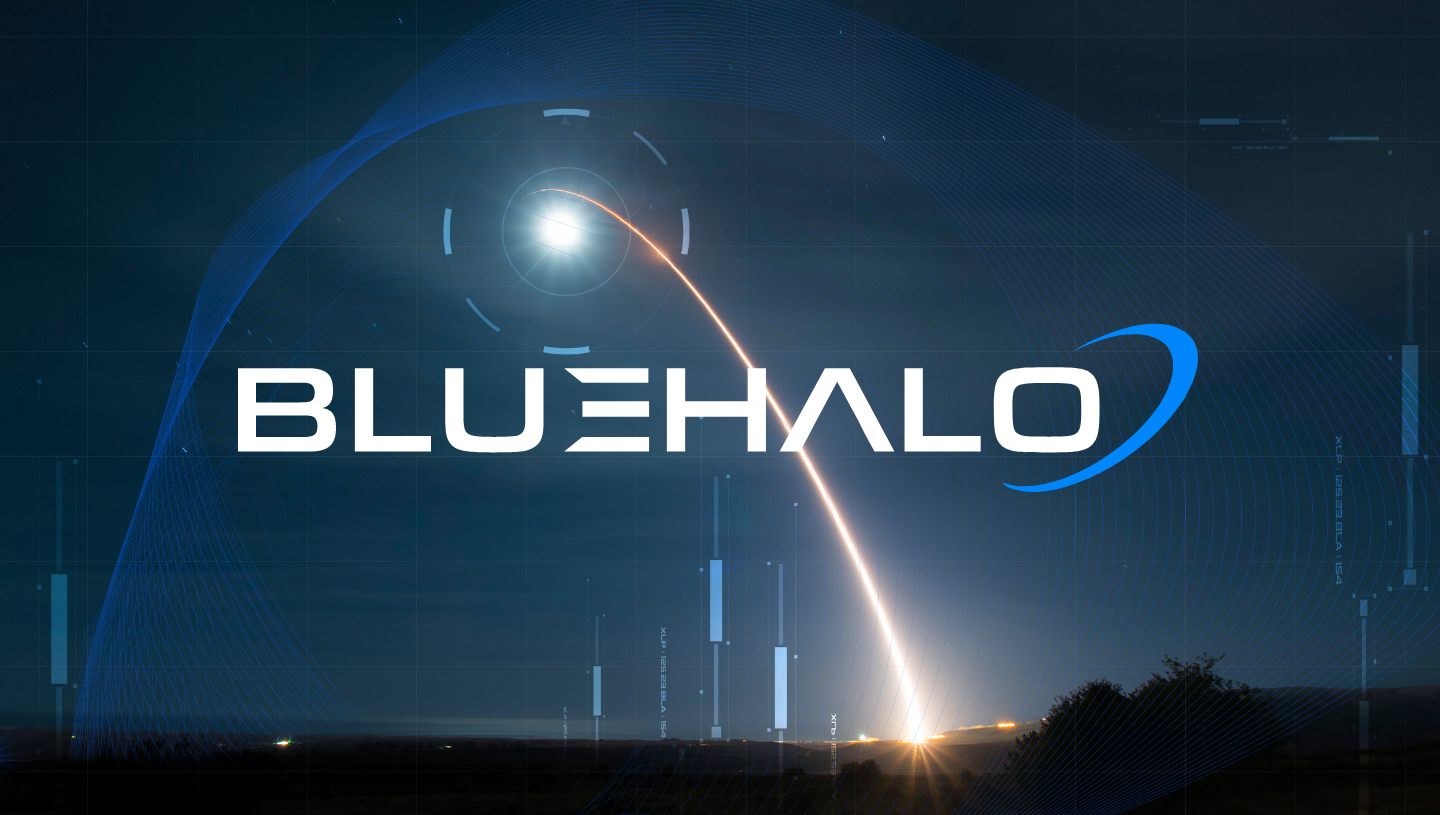
Part of what made the new BlueHalo brand so strong was the powerful corporate visual identity that Bluetext created. Bluetext moved fast to create a bold new name and brand within just weeks that would make a lasting impression on the market. The name BlueHalo represents the unbroken global line that ensures the technical advantage in the most advanced battlespace. The logo embodies the name by featuring a blue swoosh shape that depicts in a clean but strong manner, a halo of protection.
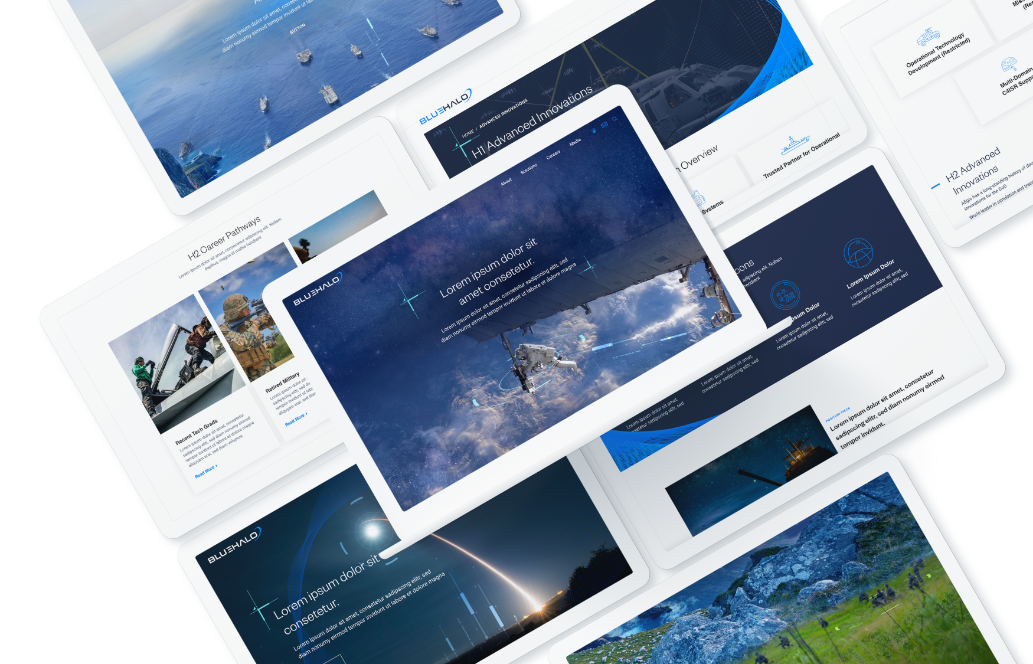
The striking blue colors to accompany the name, the branded engineering vector graphics woven in the photos to create unique, branded imagery, and the blue wires to form shapes that pull from the halo in the logo all work together to create a cohesive, meaningful, and regal brand system.
To learn more about strategic branding and how M&As can succeed with it, check out part 2 of this blog. To learn more about Bluetext and our services, contact us today.
Where is the next great opportunity for your business? Well, government agencies for one. According to USAspending.gov, approximately five trillion dollars is being allocated to government agencies in Fiscal Year 2021, with over $1 trillion going to Health and Human Services alone. These agencies are growing, and their needs for hardware, software, and services are increasing along with them.
If you are already marketing to “the government,” you understand that winning government contracts is a long sales cycle. The opportunity-to-award process might be 90 days on average, but the lead-up to those 90 days is a critical period where the deal is won or lost. During those 90 days, all data gathering and relationship-building you have done over the previous 2-5 years comes to fruition. So what exactly sets the winning businesses apart? Memorability. Government contracting is a long game, built on endurance. After many years of B2G marketing experience, Bluetext is here to break down what gets your foot in the door and sustains success in business to government marketing.

Division of time between positioning your company for success with government agencies and bidding on specific contract awards.
Winning government contracts is not as simple as pointing your existing sales and marketing engine at a new target. “The government” is not a monolithic entity, and even “the agency” needs to be treated with more nuance: It is composed of dozens of sub-entities that make independent decisions based on independent decision criteria. In enterprise sales, winning over a single decision-maker can often close the deal. In government contracts, groups of stakeholders across the agency influence which business wins the contract, even if a single decision-maker completes the signs off. So instead of persuading a single stakeholder, B2G companies are tasked with winning over multiple groups, at multiple different stages and occasions. Hence, why brand endurance is critical.
Complicating matters further, traditional channels for establishing relationships with government agencies have been disrupted by the pandemic. Most in-person conferences and meetings will not occur this year, and some will remain online for the foreseeable future. Government stakeholders are more geographically distributed and digitally dependent than ever.

The tides have shifted. Once an industry that operated in an isolated silo of its own rules, businesses seeking government contracts must adopt new, digital marketing initiatives to effectively position themselves.B2G companies should leverage the data-driven, digital marketing tools developed for B2C companies to segment and personalize their approach to agency stakeholders. B2G is too broad a term, and even business-to-agency (B2A) abstracts away from the customer understanding your company needs to have to win contracts consistently. A business-to-stakeholder (B2S) marketing approach is what your company needs to win consistently.
To succeed in data-driven B2S marketing, we explore:
- What success looks like in B2S
- The lifecycle of data-driven stakeholder cultivation
- The division of labor between internal departments for successful execution of that lifecycle.
Begin with the End Goal in Mind
Before we determine how to develop our marketing and sales pipeline, we need to define success. Agency leadership and stakeholders can frequently change, at a minimum, with every new government administration.
Therefore, we prioritize targets that will allow your company to evolve as agency priorities and decision-makers change. Your company must first make its impression as a strong, reputable industry player, whilst also remaining top of mind through consistent brand recognition and relevant thought leadership content. These are the characteristics of a successful B2A marketing approach:
- Your company is considered a thought leader in the space where the agency is procuring products and services.
- Government agency stakeholders regularly call your company to ask your opinion on upcoming agency initiatives, product and service specifications, RFPs, and contract awards. Occasionally, you are invited to co-craft the RFP in ways that position your company to win.
- You are aware of the potential for shifting priorities months before those shifts occur.
- Information on the priorities and interests of your agency stakeholders is filtering directly to your sales team, who pass relevant information to content creators, who are crafting bespoke campaigns that reach your contacts as related conversations occur internally at the agencies.
- Business development staff follow up on that content with meaningful conversations with key stakeholders. Those conversations assure your agency contacts that your company is focused on their individual and organizational priorities.
- You have both breadth and depth of relationships at the agency: deep relationships with key stakeholders and associations across the organization. A few people leaving the agency does not impact your company’s ability to retain the status and relationships described above.
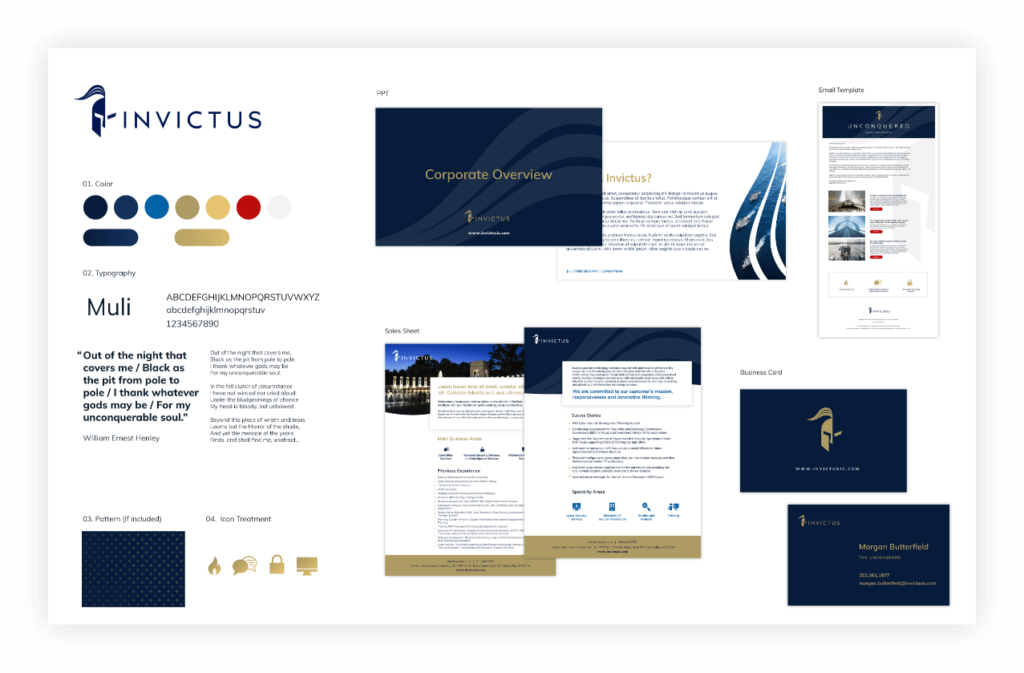
Does your content dress the part? A sure sign of a reputable industry player is professionally branded collateral assets, such as Invictus
The Stakeholder Development Lifecycle
In order to accomplish those goals, start by treating the agency as a combination of individual stakeholders and stakeholder groups. Organize your company’s sales and marketing approach around the Stakeholder Development Lifecycle for B2A marketing, which includes:
- Acquiring Stakeholder Contacts: Start with breadth. In order for your company to establish deep relationships in an agency, you need to acquire as many points of contact as possible. Target ads based on geolocation to get in front of as many relevant stakeholders as possible. Get their title, contact information, and social media presence. Build from there.
- Monitoring Stakeholder Contacts: Capture social media posts, digital content interaction (with a privacy-first approach of course), conference attendance, and internal agency relationship information from contacts over time so that you can understand and target their needs, interests, and priorities.
- Segmenting Stakeholder Contacts: Based on a contact’s position in the organization and their activities and expressed perspectives, segment them into groups that should be targeted and messaged together consistently.
- Nurturing Stakeholder Contacts: Develop marketing, business development, and sales outreach that messages contacts according to their segment and the depth of their relationship with your company. Build a customer journey map that helps you identify what messages move contacts deeper into understanding your company’s value proposition and believing in it.
- Fostering Stakeholder Promoters: Identify your company’s highest value and strongest promoting contacts as the champions your company needs to win individual contract awards. Prioritize according to how naturally the contact aligns with your company’s offerings and how important the contact is to your company’s long-term relationship with the agency.
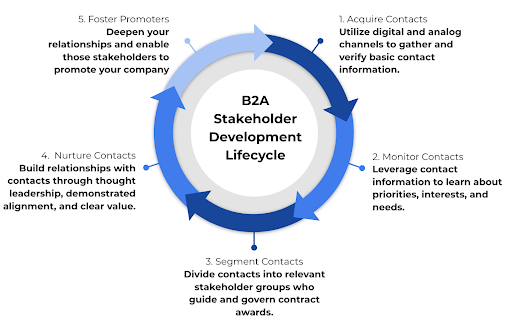
Stakeholder Development Lifecycle for B2A Marketing
Considering Stakeholder Segments
Within each agency, there are groups of stakeholders with priorities that will govern how well your company competes in a given contract award. The priorities of the agency can be efficiently stored within a single person’s head. But understanding the priorities of each stakeholder within each stakeholder group requires a data acquisition and data management approach that efficiently captures, aggregates, and generates insights about how your company is positioned with regard to that stakeholder group and the awards they oversee.
To understand how stakeholder priorities can differ, we use an example company, CyberSample, selling cybersecurity solutions to the Department of Transportation (DoT).
If CyberSample were to interface only with the DoT’s contract oversight and contract administration team, they would get a simplified and sanitized understanding of what governs the contract award. They would miss the critical details and priorities needed to assuage the concerns of each stakeholder group.
If they were to interface only with agency leadership or technology leadership, they would get a sense of broad organizational priorities and gain credibility from being introduced by internal power brokers. However, unless they leverage those introductions to dig deeper into specific needs surrounding an award, CyberSample’s team is unlikely to understand the tactical needs of technology implementers, users, or initiative leaders.
Example stakeholder groups and their corresponding priorities for CyberSample are provided in the figure below.

CyberSample stakeholder segments and their priorities. Segments and priorities should be validated by marketing interactions, public discussions, and business development and sales conversations.
Within each agency and with regard to each industry vertical selling into the agency, there will be a different set of stakeholder groups that influence decision-making. Your first task is to gather the intelligence needed to identify, segment, and target each stakeholder group. Taking a card from the B2C marketing playbook, it’s very similar to traditional customer personas, focus groups, data collection and tracking. Businesses that open their minds to alternative digital marketing and outreach methods are putting themselves miles ahead of the competition. This will allow you to move from a broad B2A approach to a more focused B2S methodology.
Executing on B2S Marketing with a Data-Driven Approach
For the approach described above to be successfully executed, each of your internal departments needs to coordinate. That coordination is built on a shared understanding of the agency landscape. A shared understanding requires a consistent and comprehensive approach to data collection, manipulation, and utilization.
Within the Contact Acquisition phase, your company’s Marketing and Content teams need to develop top-of-the-funnel landing pages, emails, webinars, white papers, and presentations that make agency contacts want to opt-in to a relationship with your company. Your Technology team needs to have the systems in place to capture customer interactions from your web properties and events, as well as to trigger intelligent outreach based on those interactions. Your Data team needs to clean and integrate the information captured from these interactions so that intelligence can filter back to Marketing, Content, Business Development, and Sales.
A summary of your company’s information needs is provided in the table below.
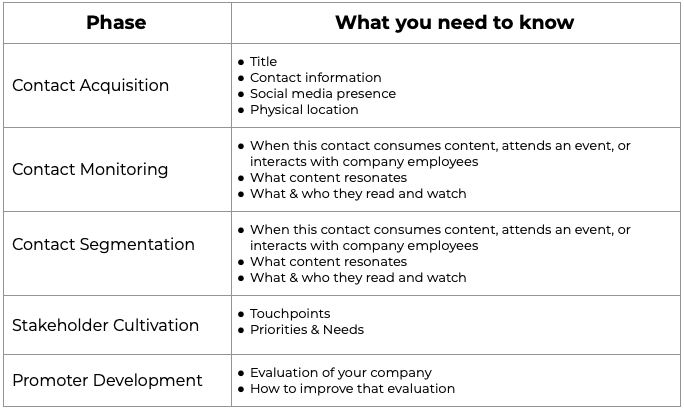
Once your company has acquired contacts and is actively monitoring activity, your Marketing, Content, and Business Development teams need to know what messages are resonating with agency stakeholders, and who are credible thought leaders through which to filter those messages. That provides the platform for new content development and for influencer marketing via the people who already have your stakeholders’ attention.
Those messages also enable the Business Development team to schedule meetings and start having conversations with stakeholders about their individual priorities and the interaction between those priorities and the organization at large. Your company can surface conflicts between agency groups to discover how to navigate potential barriers to contract awards.
Meanwhile, your Marketing team can deepen relationships with agency stakeholders through increasingly targeted messaging that moves those stakeholders closer to being promoters of your business. Your Product & Service team can ensure that your product or service value proposition is aligned with the priorities of each stakeholder group as you enter the RFP process. Your Business Development and Sales teams can focus on the individual needs of key stakeholders and customize your messaging to those stakeholders’ needs.
It is the job of your Data team to ensure that each department has the intelligence they need, when and where they need it, to effectively cultivate those relationships and respond with well-honed sales and marketing messages.
Below, we illustrate the division of labor between different departments throughout the Stakeholder Development Lifecycle.
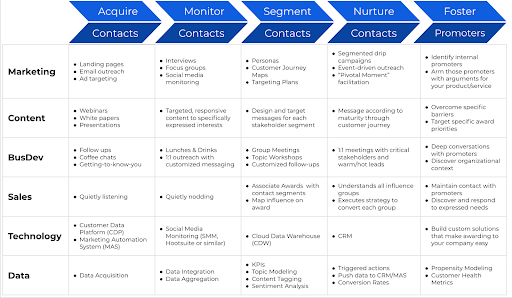
Division of Labor Between Departments for the Stakeholder Development Lifecycle
With an improved strategic approach to B2A marketing, focusing directly on the stakeholders, and a commitment to building the infrastructure and processes to gather and interpret data about them, your company will be better positioned to win government contracts for many years to come.
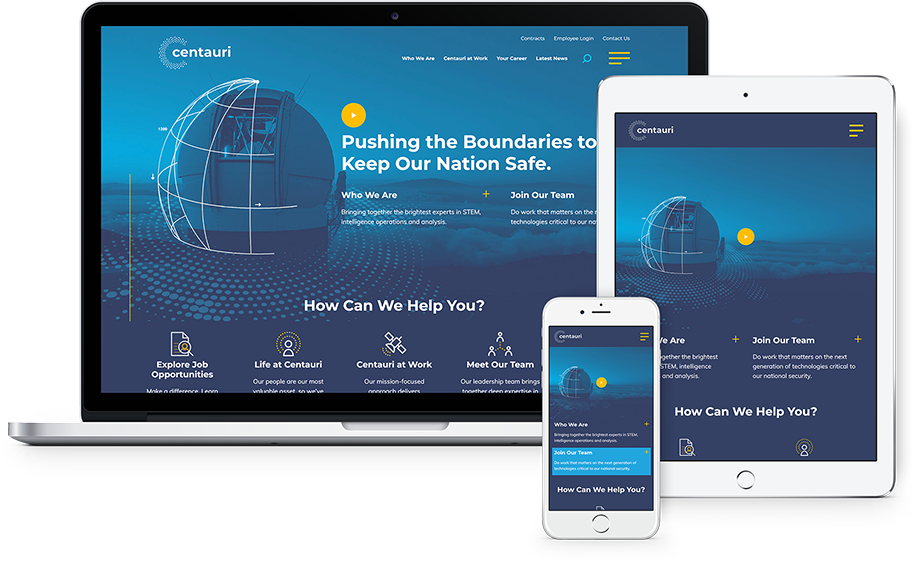
Centauri utilized Bluetext’s services to launch a new name, brand, and website following a merger. Their go-to-market strategy succeeded in winning new awards, company recruits, and even an acquisition from KBR. Check out how Bluetext has set up more brands for M&A success.
How Do I Get Started?
For the approach described above to be successfully executed, each of your internal departments needs to coordinate. That coordination is built on a shared understanding of the landscape within the agency. A shared understanding requires a consistent and comprehensive approach to data collection, manipulation, and utilization.
The starting point depends on the maturity of your company, specifically in the Data and Marketing Teams. For those with fully staffed teams that can execute, you can follow the plan outlined in this post.
The Data Team holds responsibility for timely, reliable access to data to allow the MarCom Team to execute and your other teams to act on the results. If you are still attempting to develop the overall strategy and buy-in from departmental or executive leadership, or if you don’t have the confidence in the systems in place, Bluetext has several options to help you move forward:
- Data Summit: This workshop is customized to your specific requirements, but is designed to bring together stakeholders from the relevant departments to educate them on the goals of the initiative, gather input from various departments about any concerns or limitations, and move toward a consensus regarding the strategic approach that will improve your targeted marketing efforts.
- Data & Systems Assessment: For those who have made the decision to move forward with improved data-driven marketing, it is critical to have confidence in your data systems (reliability, scalability, and accessibility), data governance (security and policies), and ROI (time to value and budget). Our assessment process addresses all of these aspects and culminates with the development and delivery of a Data Infrastructure and Capabilities Roadmap (DICR). The DICR includes the findings of the assessment, strategic vision, proposed infrastructure solution, and an implementation plan (typically phased).
With the organizational buy-in in place, and you have the data and reliable systems in place, but require assistance in execution in the marketing and content, working with industry-leading partners like Bluetext will allow you to start executing your strategy.
Bluetext brings the marketing and business development expertise needed to elevate your targeting and messaging and brings the data expertise needed to make your web, marketing, sales, and business development data work for you. Reach out to start the conversation about how we can position your company to succeed with government agency marketing and business development.

